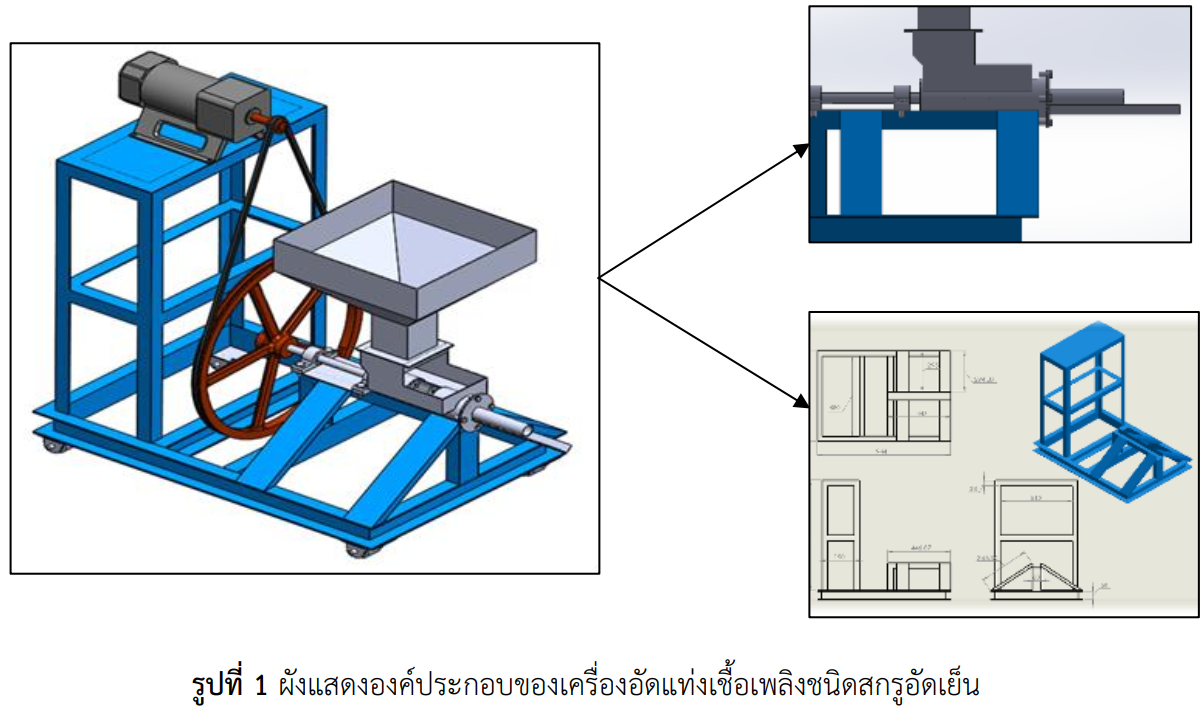การศึกษาประสิทธิภาพการใช้ความร้อนของเชื้อเพลิงอัดแท่งจากขี้เลื่อยเผา
คำสำคัญ:
เชื้อเพลิงอัดแท่ง, ขี้เลื่อยเผา, ประสิทธิภาพการใช้งานความร้อน, กระบวนการอัดขึ้นรูปบทคัดย่อ
งานวิจัยนี้มีจุดประสงค์เพื่อศึกษาประสิทธิภาพการใช้ความร้อนของเชื้อเพลิงอัดแท่งจากขี้เลื่อยเผาด้วยการใช้ตัวประสาน 3 ชนิด ได้แก่ แป้งมันสำปะหลัง กากน้ำตาล และน้ำมันยางนา เพื่อหาอัตราส่วนผสมระหว่างตัวประสานกับขี้เลื่อยเผาที่ดีที่สุดต่อประสิทธิภาพการใช้ความร้อนของเชื้อเพลิงอัดแท่งจากขี้เลื่อยเผานี้ กระบวนการอัดขึ้นรูปเชื้อเพลิงใช้เทคนิคการอัดแบบสกรูอัดเย็น โดยใช้เครื่องอัดแท่งเชื้อเพลิงขนาดมอเตอร์ 3 แรงม้า อัดขึ้นรูปที่ความเร็วรอบเกลียวอัด 270 รอบต่อนาที โดยการหา ความหนาแน่น ความแข็งแรงทางแรงกด และค่าความร้อน
ผลการทดลองพบว่า ความหนาแน่น ความแข็งแรงทางแรงกด ค่าความร้อน และประสิทธิภาพการใช้ความร้อนที่ได้จากเชื้อเพลิงอัดแท่งที่ใช้น้ำมันยางนาเป็นตัวประสานมีค่าสูงที่สุดที่อัตราส่วนโดยมวลตัวประสานกับขี้เลื่อยเผาเท่ากับ 0.5:7 โดยให้ค่าความหนาแน่น ความแข็งแรงทางแรงกด ค่าความร้อน และประสิทธิภาพการใช้ความร้อนสูงสุดอยู่ที่ 589.46 กิโลกรัมต่อลูกบาศก์เมตร 226.69 เมกะปาสคาล 16.88 เมกะจูลต่อกิโลกรัม และ 20.25% ตามลำดับ
เอกสารอ้างอิง
Amarasekara, A., Tanzim, F. S., & Asmatulu, E. (2017). Briquetting and carbonization of naturally grown algae biomass for low-cost fuel and activated carbon production. Fuel, 206, 612-617. doi:10.1016/j.fuel.2017.07.034
Counaphonviwat, T., Sawadkit, A., Gunha, J., Ratanasangwong, P., & Phankong, W. (2007). A study of the Possibility in Producing Biodiesel from Rubber Tree Oil. Proceedings of the 21 National Mechanical Engineering Conference. Chonburi. Retrieved from https://dspace.spu.ac.th/handle/123456789/162 (In Thai)
Department of Alternative Energy Development and Efficiency. (2017). Energy situation, Thailand. Retrieved March 26, 2020, from http://www.dede.go.th/download/state_61/frontpagejan_nov60.pdf
Faizal, M. (2017). Utilization of biomass and coal mixture to produce alternative solid fuel for reducing emission of greenhouse gas. International Journal of Advanced Science, Engineering and Information Technology, 3(2), 950–956. Retrieved from https://www.researchgate.net/publication/317853122
Namwong, K., & Khathaphan, M. (2017). Design and development of a briquette machine for briquettes production from dried neem leaves and burned sawdust. Proceedings of the 31st National Mechanical Engineering Conference, (pp. 65–73). Nakhonnayok. Retrieved from https://www.tsme.org/index/phocadownload/MENETT31/AEC/aec06.pdf (In Thai)
Nomura, S. (2016). Coal briquette carbonization in a slot-type coke oven. Fuel, 185, 649–655. doi:10.1016/j.fuel.2016.08.031
Ranaivoson, T., Rakouth, B., Buerkert, A., & Brinkmann, K. (2017). Wood biomass availability for smallholder charcoal production in dry forest and savannah ecosystems of south-western Madagascar. Fuel, 146, 86–94. doi:10.1016/j.fuel.2017.03.026
Sangsuk, S., Buathong, C., & Suebsiri, S. (2020). High-energy conversion efficiency of drum kiln with heat distribution pipe for charcoal and biochar production. Energy for Sustainable Development, 59, 1-7. Retrieved from https://www.sciencedirect.com/science/article/pii/S0973082620302891
Srinoun, A., & Chainawa, A. (2018). A study of fuel briquettes from Casuarina junghuhniana Miq. leaf-lignite blends. Kasem Bundit Engineering Journal, 8(1), 128–151. Retrieved from https://ph01.tci-thaijo.org/index.php/kbej/article/view/133128 (In Thai)
Tangmankongworakoon, N. (2014). The Production of Fuel Briquettes from Bio-agricultural Wastes and Household Wastes. Srinakharinwirot University Journal of Sciences and Technology, 6(11), 66–77. Retrieved from https://ejournals.swu.ac.th/index.php/SWUJournal/article/view/4488 (In Thai)
Thepsaskul, W., Thammachat, W., & Intaniwet, A. (2016). Investigation of coconut shell carbonization fuel briquettes fabrication. 12th Conference on Energy, pp. 610–618 (In Thai).
Tippayawong, K. Y., Santiteerakul, S., Ramingwong, S., & Tippayawong, N. (2019). Cost analysis of community scale smokeless charcoal briquette production from agricultural and forest residues. Energy Procedia, 160, 310–316. doi:10.1016/j.egypro.2019.02.162

ดาวน์โหลด
เผยแพร่แล้ว
รูปแบบการอ้างอิง
ฉบับ
ประเภทบทความ
สัญญาอนุญาต
ลิขสิทธิ์ (c) 2024 มหาวิทยาลัยราชภัฏสวนสุนันทา

อนุญาตภายใต้เงื่อนไข Creative Commons Attribution-NonCommercial-NoDerivatives 4.0 International License.
บทความที่ได้รับการตีพิมพ์เป็นลิขสิทธิ์ของ สถาบันวิจัยและพัฒนา มหาวิทยาลัยราชภัฎสวนสุนันทา
ข้อความที่ปรากฏในบทความแต่ละเรื่องในวารสารวิชาการเล่มนี้เป็นความคิดเห็นส่วนตัวของผู้เขียนแต่ละท่านไม่เกี่ยวข้องกับมหาวิทยาลัยราชภัฎสวนสุนันทา และคณาจารย์ท่านอื่นๆในมหาวิทยาลัยฯ แต่อย่างใด ความรับผิดชอบองค์ประกอบทั้งหมดของบทความแต่ละเรื่องเป็นของผู้เขียนแต่ละท่าน หากมีความผิดพลาดใดๆ ผู้เขียนแต่ละท่านจะรับผิดชอบบทความของตนเองแต่ผู้เดียว




